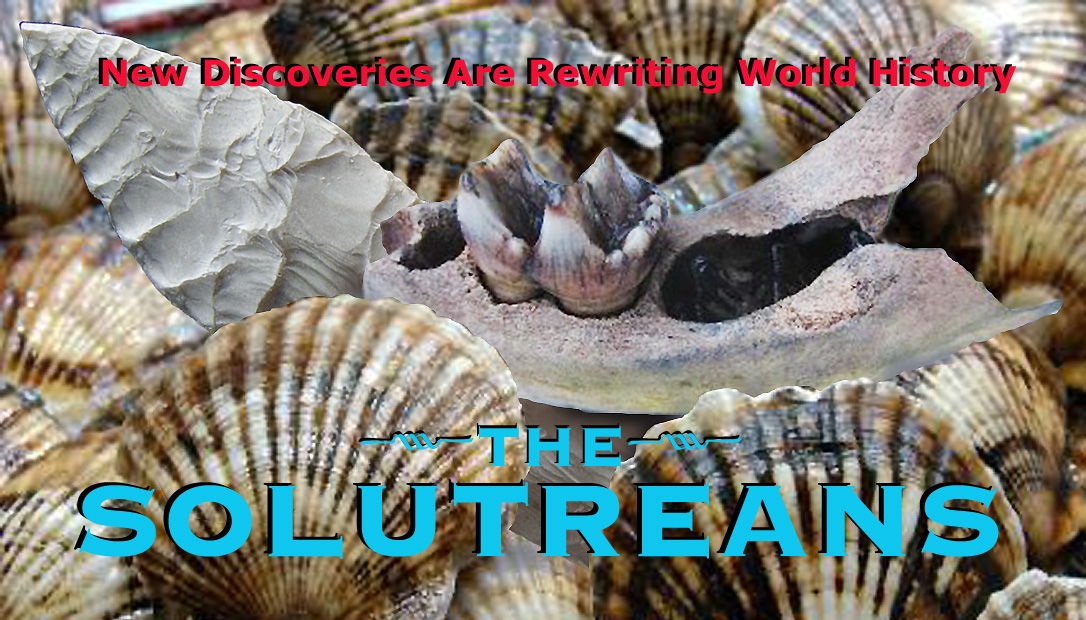

We can only guess about the traditions and social structure of both the Solutreans and Clovis cultures. Their stone tools have survived through the eons of time but almost everything else has disintegrated to dust.
A few clues to their hunting skills have been found etched in sone and ivory and reveal that they did not actually throw their spears by hand. There is strong evidence that these long projectiles were hurled at prey with a device called an atlatl.
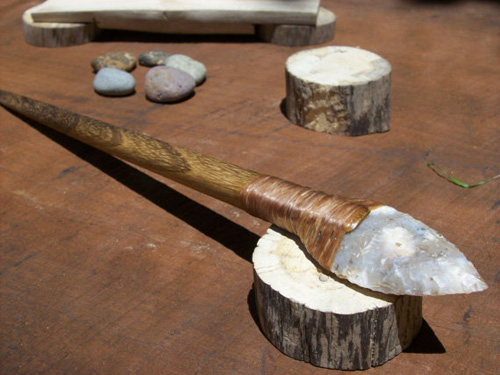
[Above] The stone points were fastened to a long, straight wooden shaft by animal sinew -- a piece of tissue usually connecting muscle to bone or bone to bone. When this material dried it was extremely strong.
It is thought that the spears also had some feathers attached to the end which would have helped control the trajectory much the same way as arrows. We think this is the case because we have found several images of animals from the Solutrean era with what appears to be fletched darts in their back bearing feathers [Below].
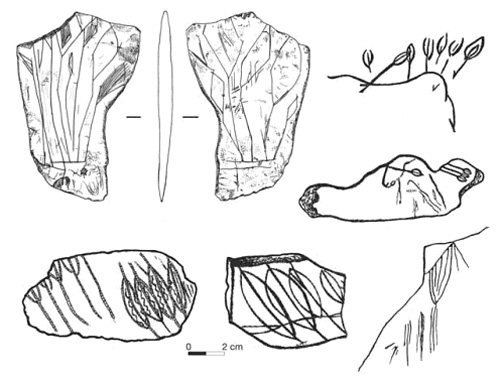
We see this not only in European artifacts from the Solutrean era but also in North American petroglyphs of the Clovis culture [Below].

The atlatl was a hand held stick with a notch at one end to accommodate the end of the spear. It worked much like a lever in that small movements of the hunters arm were translated into larger movements of the spear.
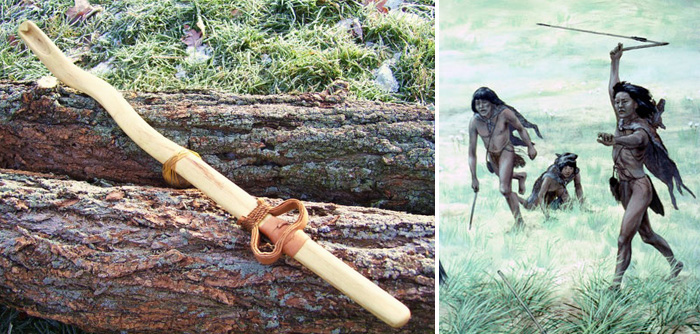
Because the spear and stone point were heavy, and because the spear and atlatl were thrown from the end of the projectile, it was often necessary to add a stone weight as a counterbalance [Below]. When perfectly balanced the delivery of the projectile to its target was highly accurate and deadly. The razor sharp spear easily penetrated even the toughest hide of a mastodon and with sufficient force to mortally wound it.

Language and Art
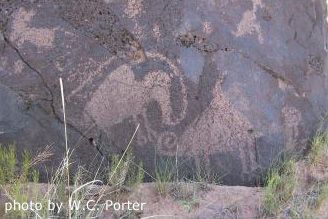 The Clovis culture endured in North america for only a fragment of the time that the Solutreans thrived in Europe. Aside from some petroglyphs of mastodons [Right] and even fewer questionable cave paintings, Clovis left very little in the form of art aside from their exquisitely crafted spear points. Perhaps the reason for this is that there are fewer caves in North America to preserve their art or it may be that their population was smaller than we think and concerned mainly with survival.
The Clovis culture endured in North america for only a fragment of the time that the Solutreans thrived in Europe. Aside from some petroglyphs of mastodons [Right] and even fewer questionable cave paintings, Clovis left very little in the form of art aside from their exquisitely crafted spear points. Perhaps the reason for this is that there are fewer caves in North America to preserve their art or it may be that their population was smaller than we think and concerned mainly with survival.
[Below:] 13,000 year old art found in Florida and corresponding to the end of the Clovis Culture [source].The engraving, approximately 13,000 years old, is 3 inches long from the top of the head to the tip of the tail, and 1.75 inches tall from the top of the head to the bottom of the right foreleg. (Credit: Chip Clark/Smithsonian)
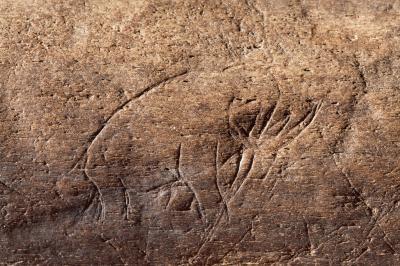
In contrast, the Solutreans gave us many examples of their talent in cave art depicting the animals that they knew well [Below].
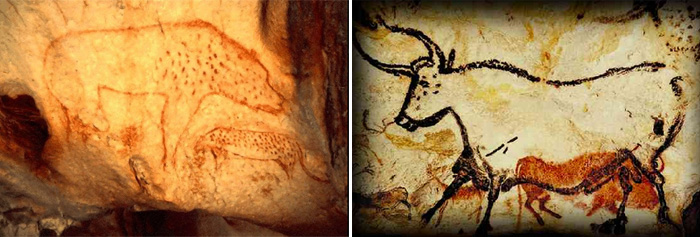
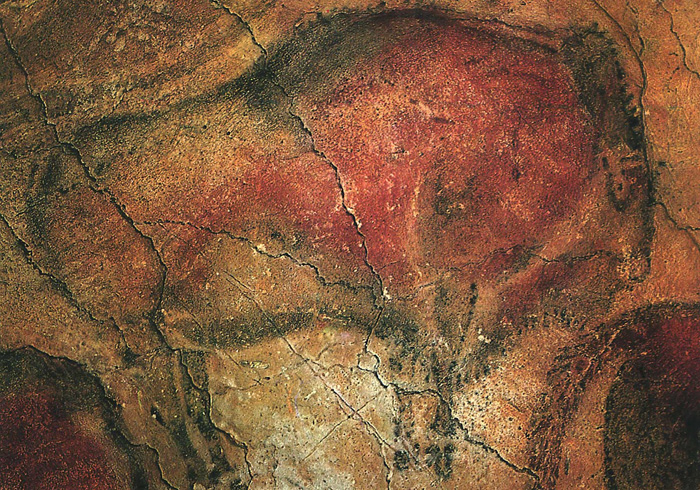
It is often said that a picture tells a story. This is probably true of the Clovis and Solutreans. But we are absolutely certain that they had a spoken language. The production of their stone points is so exact and uniform that it must have been taught. The many steps required had to be remembered and recalled by some internal dialog.
Social organization and culture require a rich vocabulary to transmit new ideas and maintain traditions. Although these people were what we might consider "stone age" they were by no means primitive or stupid. Their ability to survive a trans-Atlantic migration in some of the harshest conditions on Earth, as well as their conquest of the New World from East to West, attests to their intellect and creativity.
New petroglyph discoveries in the Pyramid Lake region of Nevada, dated to about 13,000 to 15,000 years ago, may hold the clue to their language. This author has noted repeating symbols that appear to represent phonetic values at this site as well as others of a similar age in SE Colorado. Rather than attempt to describe these here, I will soon post a separate story which will detail these exciting finds.
For now, enjoy the re-write of history as the Solutreans finally have their day!

Reader's Comments
There is a misleading story in Science Daily which suggests that the skeletal remains of a 24,000 year old male, found in Siberia, has DNA similar to Native Americans. The article says this proves that the Asians were in North America before "other people" (they could not bring themselves to even mention the Solutreans).
The fact that current Native American Indians share DNA with Asians who migrated through Beringia (from Siberia to Alaska) has never been disputed by the Solutrean hypothesis. What is debated is WHEN this migration happened.
Solutreans have been found to exist in North America at around 26,000 years BP. Their spears have been found and, as this article in viewzone pointed out, traced back to a flint quarry in France. The fact that a 24,000 skeleton has DNA that resembles modern Native American Indians does not prove that they arrived before the Solutreans. I think anyone who knows about these things can see that the Science Daily story is totally bogus in its claims.
Thanks for writing this story also. It was great. I look forward to your article about the language and writing.
R.Vaughn
I totally agree with the assessment by Mr. Vaughn. It is ironic how people hate the Solutrean hypothesis, some even calling it racist! When anthropoligists speak of "Eropeans" many people think of modern people but fail to remember that this was a Europe of more than 25,000 years go. The race and ethnicity of the Solutreans is far different from the current inhabitants and their descendants have since migrated to western Europe and 'god only knows where'.
Likewise, the "Siberians" and other Asians who crossed Baringia are far different from the people who inhabit these regions today. It's ridiculous to doubt the Solutrean hypothesis with so much evidence.
RuthG
While your article is well written and researched, I would not yet dismiss the Beringia theory that Asians were the ancestors of Clovis. Many of the points you raised have equally convincing critiques and conflicting data which, although they do not support the Beringia theory, seem to discount the Solutrean hypothesis.
Because the coastal areas where most of the evidence could possibly be located are now under the ocean, we will have to wait for more information to make any conclusion about who was here, from where, and when. I suggest keeping an open mind and entretaining the Solutrean hypothesis as just that -- a hypothesis that is waiting to be proved.
BRadcliff
There certainly does seem to be a lot of racism and emotion connected with the theory of who was in america the first. I really do not understand why this is so. It seems to muddy the water in trying to understand the facts. We should all just keep cool about this and let the facts tell the story. But good article anyway.
RLaviolete
There is a great video series in 5 parts that discusses some of the refuting info on the Solutrean hypothesis. It's at http://www.youtube.com/watch?v=yDScxPObgBw and worth a view.
MSoffen
Notes:
[1] Dennis J. Stanford and Bruce A. Bradley, ACROSS ATLANTIC ICE: The Origin of America's Clovis Culture, University of California Press, 2012, ISBN 978-0-520-22783-5 (available from amazon.com)
I have been told that the dot diagrams in the Iberian/French caves are representations of water. Ancient humans looked out across the lakes and oceans and saw vast expanses of water. What impressed them the most was the sparkling glints of light patterns that waves and sun create.
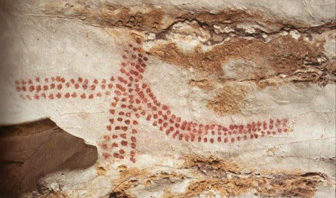
These "diamonds" on the surface became magical to them as they defied explanation and had no corporeal existence. To them water was also an impassable barrier that only certain animals had the capacity to enter it. Magic, water, and these certain animals became symbols of spiritual power and awe. Shamans recognized that both light and bodies of water were a different form of reality. With this view of water their symbolic representations became "polka dots of light".
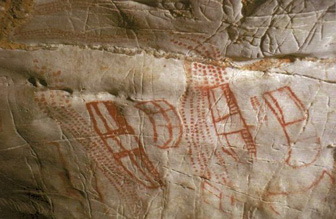
The above pictograph from the El Castillo Cave is a good example of this understanding. The dots are rivers of water and on these rivers are hide stretched boats, obviously a powerful impression to be recorded and talked about in a legend.
You can see on the right side there is a boat on the water, as the water is covered by the rear part of the boat. The boat sits on the water covering the area that it occupies, from that perspective. The object above this boat it is a sail full of wind, but not fully recognized by the observer as to how it is attached to the boat. There is a start of a mast in the middle of the boat but time has erased it or it was never recognized and recorded.
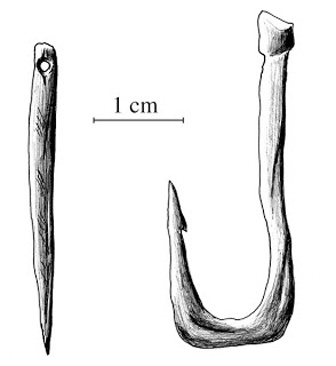
[Above] Hooks and needles, made from bone, have been found at Solutrean sites.
Both the boat and the sails are stitched together with more than one piece of hide. In fact the gunwale (gunnel) can also be seen with more stitching as it is an attachment area to the wood frame. You can also see on the left boat the middle section had two smaller hides sewn together, showing there was more than one boat being observed.
There is no archaeological record of boats from that time but here is proof from 20,000 BP. That and the fact Aboriginal people had somehow made it across the ocean to Australia 40,000 years prior to this painting.
The painting below is also from El Castillo Cave, Spain (of Solutrean origin) and shows another river system or the same one with a different part of the story.
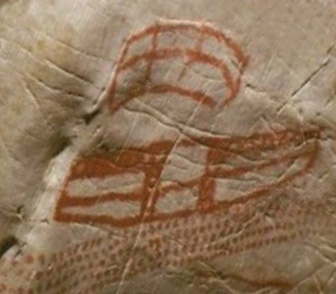
Water and the magic of the dots were also incorporated into many different symbolic pieces of art. This includes animal guides and shaman power animals. The wet horse shown below had many different symbolic overlapping concepts in one image.
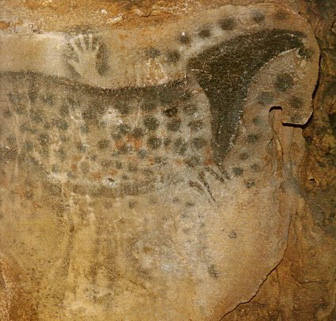
[Source of this wonderful information on Solutrean boats and water.]